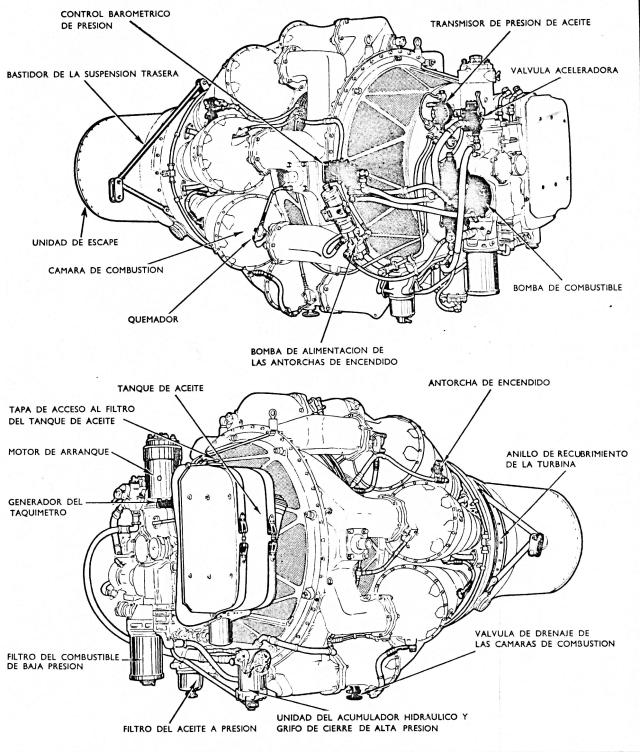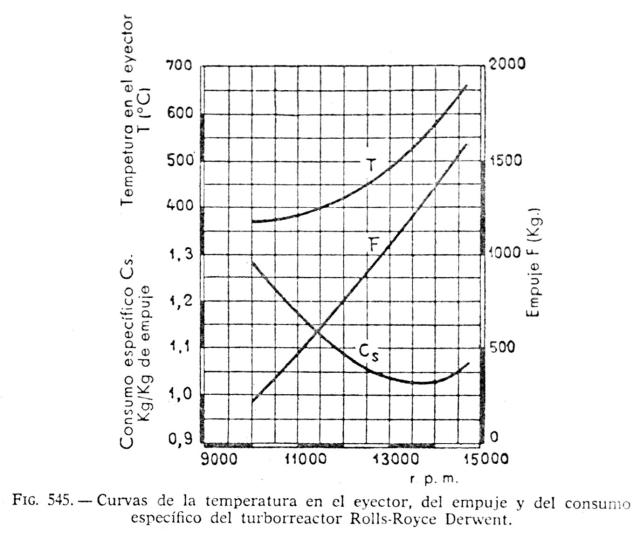| Building factory: Rolls-Royce (U.K.) |
| Weight: 582 (+2.5%) kgf. |
Type: Pure turbojet with double faced centrifugal compressor, 9 combustion chambers and one stage turbine.
|
| Maximum thrust: 1 636 kgf. |
| Weight/thrust ratio: 0.365 kgf/kgft. |
| Specific consumption: 1.030 kgf/kgft/h. |
| Rotation sense: hourly, seen from front. |
Compressor: centrifugal, single stage
double impeller aluminum alloy made, with diffusors and 9 tangential outlets
connected to the corresponding combustion chambers.
Outer diameter: 1.092 meters. Theorical compression ratio: 4.0:1 and air mass flow of 29.2 kgf/seg @ static 14 700 RPMs. |
Combustion chambers:
9 interconnected ones of Nimonic 75 steel alloy, with Simplex burners.
|
Turbine: one stage axial flow type with 54
Nimonic 80 steel alloy socket mounted blades.
Inlet temperature: 895 °C. |
| Exhaust jet tube: fixed without post-combustion. |
Main fuel system: it has a booster pump, a cut-off main valve,
a 20 micron filter, a control fuel unit equiped with a main pump with a pressure of 105 kgf/cm2,
an overspeed governor and a flow control by barometric pressure variance.
The feeding system is done through a piston pump model Lucas G.C.i2 driven by a moving plate
with servo integral mechanism.
|
Fuel: aviation kerosene according to English specification RDE/F/KER plus
1% of oil according to English specification DED 2472 B/O.
|
Starting fuel system: it has an electrical trowel pump with a working pressure of 2,10 kgf/cm2 and two torches.
|
Lubrication System: by dry case with pressure feed to the main bearings,
connection and ejector of the gears box. Oil tank, independent,
mounted on the gears box with capacity of 12,5 Liters.
|
| Lubricant: mineral oil according to norms DTD.44D. |
Starting System: high voltage ignition spark plug combined with a sprayer fed by solenoid
valve installed in the combustion chambers number 3 and 8.
It has an electric starter with centrifugal pawl and a system of
resistances that allow two starting times.
|
| Ignition system: DC 24 Volts circuit. It has two coils and two torches. |
Back bearing refrigeration system: it has a system of cold air circulation forced by a secondary centrifugal compressor.
|

Thermodynamic operation and circuit of air*
The air of admission enters the double impeller compressor through the front and rear intakes, and is guided towards the inlets of the compressor's rotor by fixed toroidale guide blades, which balance the distribution of the incoming air on the rotating guide blades which comprise the compressor's rotor assembly. When this last rotates, the air is thrown at high speed from the tips of the blades, and it is guided within a diffusing ring where its kinetic energy is partially turned into pressure energy.
From the burners the fuel is sprayed at high pressure which is aviation kerosene, in finely atomized form, within flame tubes mounted concentrically inside the combustion chambers, where they burn in a continuous way with approximately 25% of the total air flow. The heat thus generated expands the remaining air, increasing its speed at the same time, whereas the dilution of air in relation from three to one, approximately, reduces the temperature of combustion hot products to a level that is acceptable for the materials of the assembly of the turbine.
The dilution is completed through holes in the flame tubes; the hot gases of each combustion chamber go to the inner assembly of the unloading conduit that contains a ring of fixed blades that directs gases towards and over the blades of the turbine. In this form, a part of the energy of the gas is used to rotate the wheel of the turbine, which drives the compressor, the cooling air ventilator and the gearbox's gears train. After leaving the turbine, the gases pass through the exhaust unit, jet tube and assembly of the propulsion nozzle, from which they leave in the form of a propulsion jet of high speed.
For T.P.N.C. (ambp.=1.033 kgf/cm2 or 1013 mb, ambt.=15 °C or 288 K) performances are:
|
|
|
Maximum output jet temperature |
|
| Combat takeoff | 14 700 |
680 °C |
|
| Ascending | 14 100 |
630 °C |
|
| Cruise speed | 13 600 |
580 °C |
|
| Slow run (0-6 000) m. |
3 500 +-200 |
500 °C |
|
| Slow run (6 000-9 000) m. |
7 000 |
500 °C |
|
| Slow run (9 000+) m. |
10 000 |
500 °C |

*: Data extracted from the manual of maintenance of Rolls-Royce Derwent V turbojet employed by Fuerza Aérea Argentina.